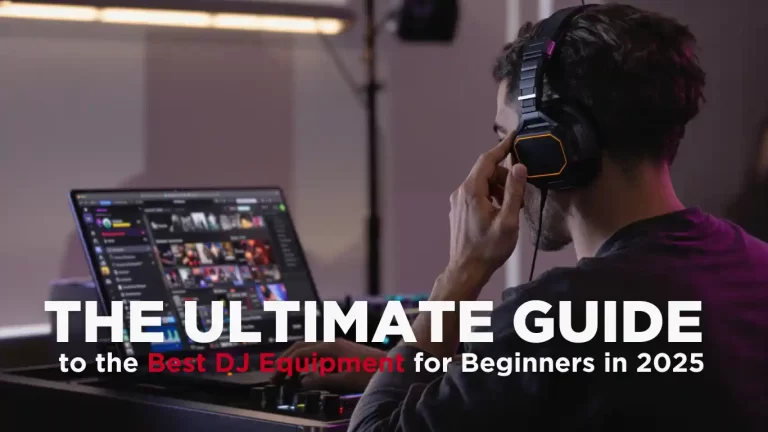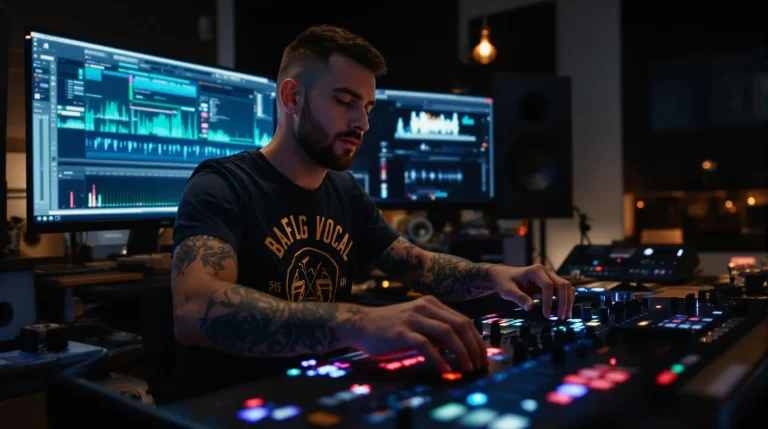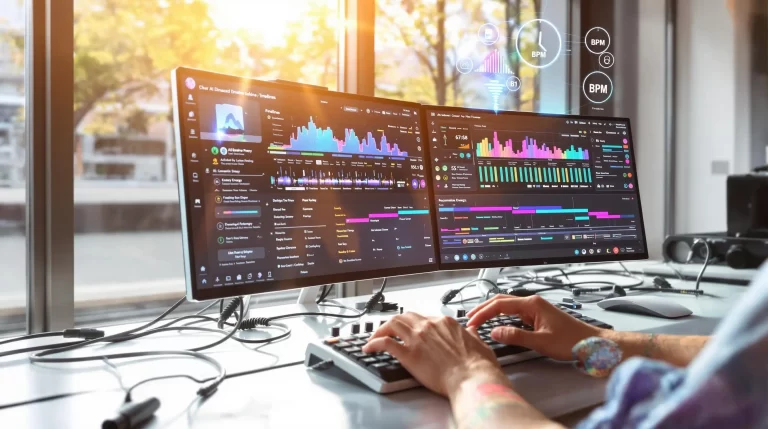Enhancing DJ Sets with AI-Driven Beat Matching Techniques
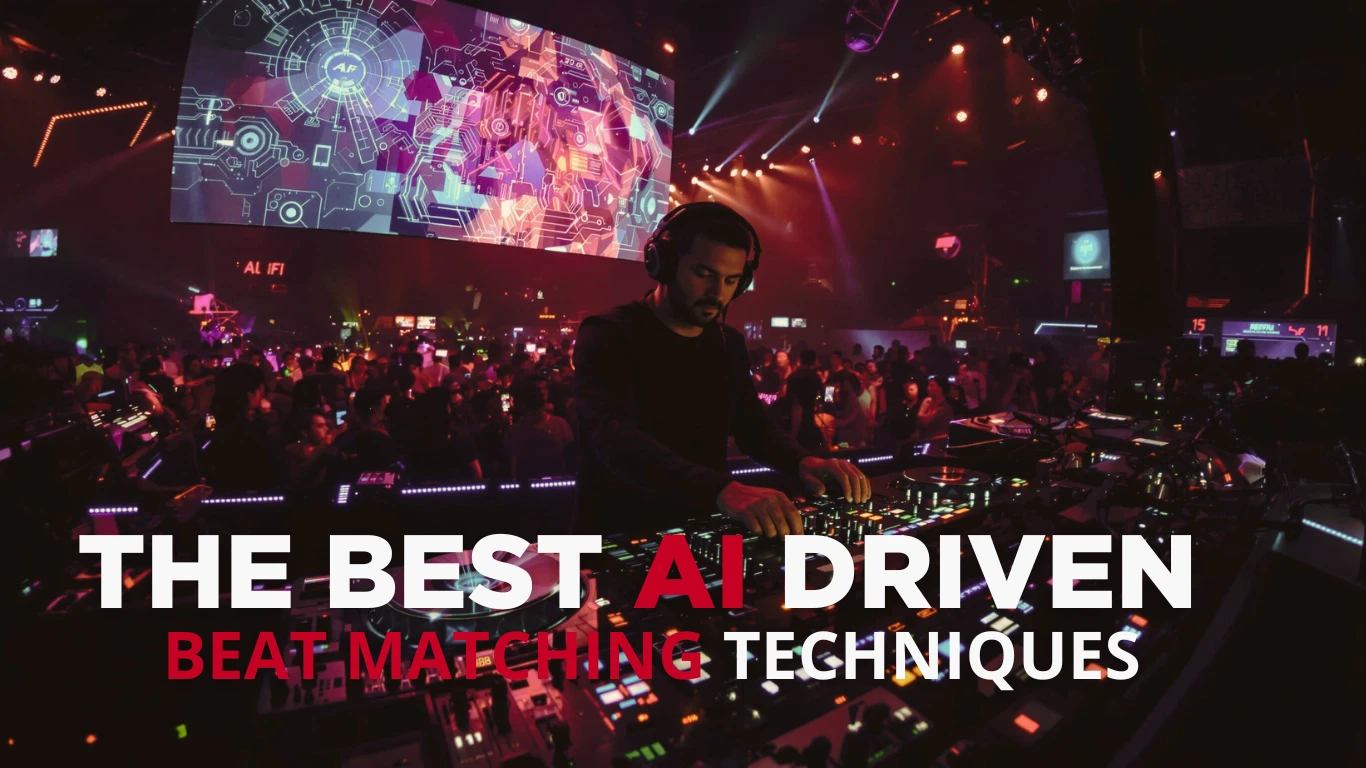
Scott Evans DJ is supported by its readers. If you purchase through any link on the site, we may earn a commission. Learn more
Introduction
AI is changing the world of DJing, greatly influencing live performances. Beat matching is still a crucial part of music mixing, guaranteeing seamless transitions between songs and keeping the audience interested.
In this article, you will learn about:
- The basics of AI-driven beat matching techniques
- Important features that improve traditional DJ methods
- Benefits of using AI in your DJ performances
- Tools and software that utilize AI capabilities
- Obstacles DJs encounter when embracing these new technologies
- Future possibilities for AI integration in DJing
Explore the intersection of technology and music, and learn how to enhance your DJ sets!
Exploring AI-Driven Beat Matching Techniques
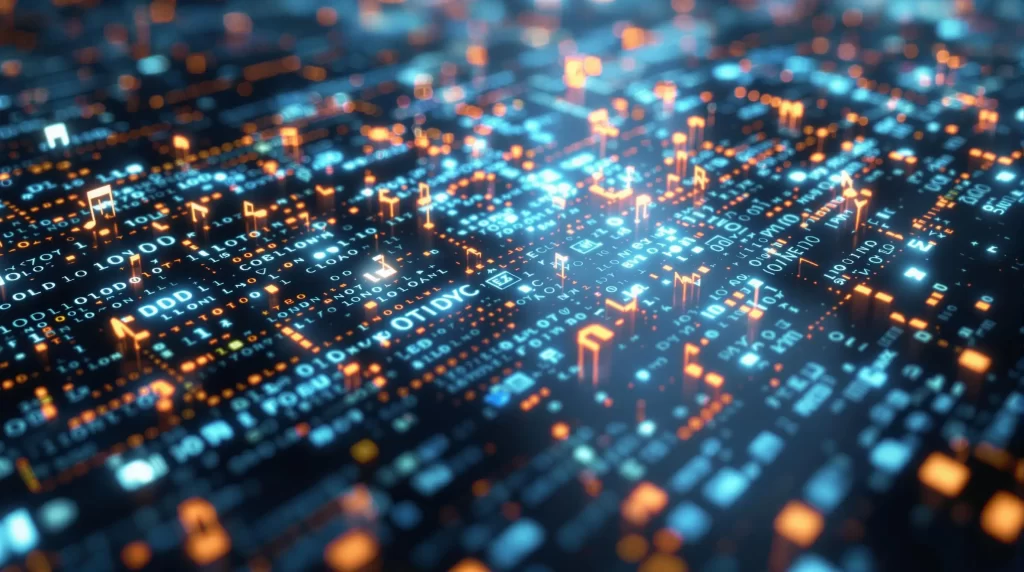
In recent years, AI-Driven Beat Matching Techniques have revolutionized the music industry, offering innovative solutions for both amateur and professional musicians alike. One of the standout applications of this technology is AI music generation, which assists artists in creating unique compositions by analyzing vast datasets of existing music.
By understanding patterns and structures, AI can craft new melodies and harmonies that resonate with listeners. This technology is particularly beneficial for DJs who rely on precision and creativity. DJ beat matching, a crucial skill for any DJ, has been significantly enhanced by AI, allowing seamless transitions between tracks. The use of AI-Driven Beat Matching Techniques ensures that beats align perfectly, maintaining the energy on the dance floor without missing a beat.
Moreover, music with AI isn’t just limited to DJs and producers. It’s transforming how music is composed and appreciated across various genres. Key features include real-time tempo adjustments and genre-specific beat recommendations, making it easier for artists to experiment with different styles and sounds. By leveraging AI-Driven Beat Matching Techniques, musicians can explore new creative avenues while ensuring their tracks maintain a professional quality.
The integration of AI in music creation tools empowers artists to push boundaries, enabling them to focus more on artistic expression rather than technical constraints. With AI-Driven Beat Matching Techniques, musicians can seamlessly synchronize various elements, enhancing their creative process. The ability to quickly adapt and refine musical elements with precision is what makes AI-driven solutions, including AI-Driven Beat Matching Techniques, a game changer in the music landscape.
Understanding AI-Driven Beat Matching Techniques
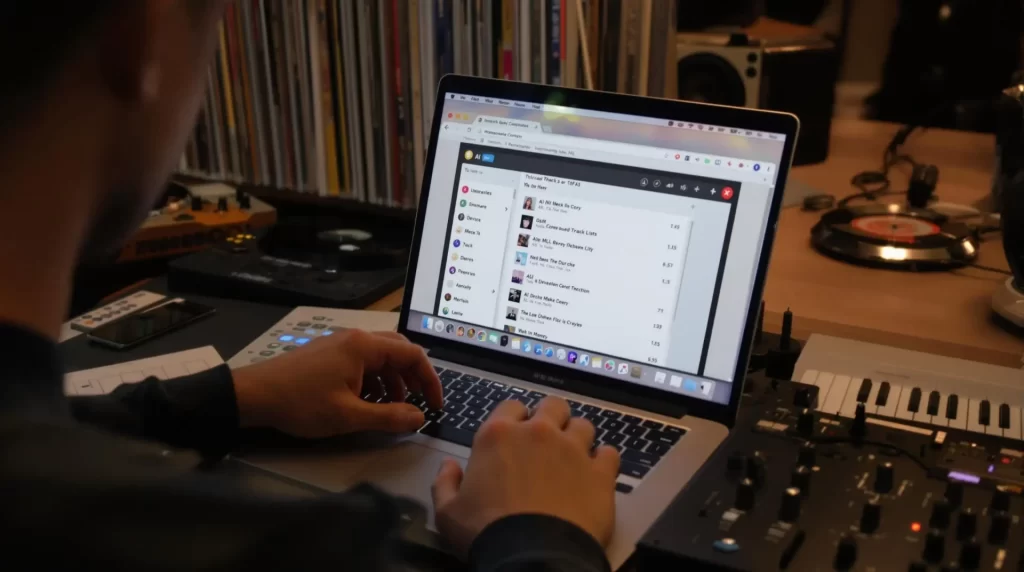
AI-driven beat matching techniques are changing the DJing scene by using advanced technologies to improve traditional methods.
What is AI-Driven Beat Matching?
AI-driven beat matching is when machine learning algorithms are used to analyze and synchronize the beats of different songs in real time. This makes it easier for DJs to smoothly transition between tracks during live performances.
Key Features of AI-Driven Beat Matching
Here are some important features of AI-driven beat matching:
- Automated Transitions: These technologies enable smooth crossfades between tracks, reducing the manual effort required for beat matching.
- Stem Separation: DJs can isolate specific elements, such as vocals or instruments, allowing for live remixing and creative flexibility.
- Real-Time Analysis: Tracks are analyzed based on frequency content and arrangement. This capability ensures that the DJ can maintain a cohesive set, adapting dynamically to changes in tempo or key.
With these features, AI-driven tools empower DJs to focus more on their performance while relying on intelligent systems to handle complex technical tasks. This combination of creativity and technology is shaping a new era for live music experiences.
Advantages of Incorporating AI in DJing
Incorporating AI into DJing offers significant advantages that enhance both workflow optimization and creative possibilities.
1. Streamlined Workflows
Automation of routine tasks allows DJs to focus on the art of mixing. AI-driven tools can suggest track combinations, analyze tempo, and identify key signatures, reducing the time spent on manual adjustments. This frees up mental bandwidth to engage more deeply with the crowd.
2. Enhanced Creativity
Intelligent recommendations provide DJs with new ideas for setlists, introducing them to tracks they might not have considered. By leveraging AI’s ability to analyze music patterns and audience preferences, DJs can craft unique experiences that resonate with listeners.
3. Improved Mixing Capabilities
Features like harmonic mixing and automix capabilities enable seamless transitions between tracks. These functions organize songs by tempo and key, allowing for smooth blends without the need for constant manual intervention. As a result, DJs can maintain a continuous flow, enhancing the overall experience.
AI not only streamlines technical aspects but also opens up a world of creative exploration, encouraging DJs to push boundaries while staying connected to their audiences.
Adapting AI to Live Performances
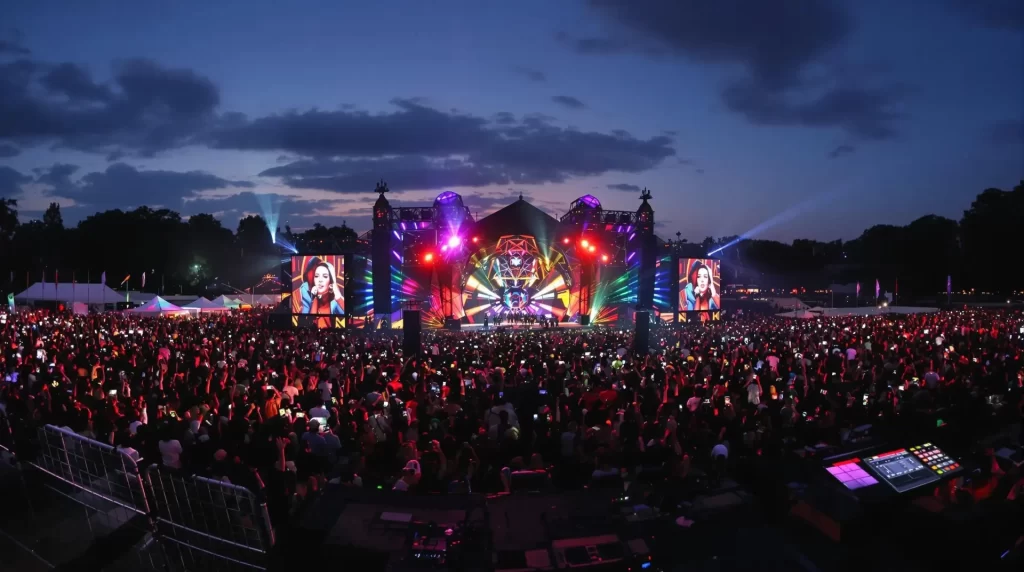
The integration of AI into live DJ performances significantly enhances audience engagement.
1. Real-time Adaptation
AI tools analyze crowd reactions, suggesting tracks based on mood and genre. This capability allows DJs to dynamically select music that resonates with the audience, creating a more interactive experience.
2. Tempo Adjustments
Maintaining an engaging atmosphere is crucial during performances. AI-driven beat matching techniques enable DJs to make quick tempo adjustments, seamlessly aligning the energy of the set with the crowd’s vibe. This responsiveness helps sustain momentum, ensuring that the performance feels fluid and cohesive.
By leveraging these intelligent features, DJs can elevate their sets beyond mere mixing. They become able to read the room effectively and respond in real-time. As a result, performances transform into collaborative experiences between the DJ and the audience. The ability to adapt dynamically leads to unforgettable dance floor moments, solidifying the role of technology in enhancing DJ sets through AI-driven beat matching techniques.
Tools and Software for AI-Driven Beat Matching
The rise of AI in DJing has led to the emergence of powerful tools designed to enhance mixing capabilities. DJ software now integrates advanced functionalities, streamlining workflows and elevating live performances.
Key Tools and Features:
1. DJ.Studio
- Utilizes machine learning algorithms to analyze tracks, facilitating seamless transitions.
- Offers automated beatmatching, aligning beats for effortless mixing.
- Incorporates stem separation, allowing DJs to isolate elements like vocals or instruments for live remixing.
- Features harmonic mixing capabilities, matching tracks based on their musical keys for a cohesive set.
2. Other Notable AI-Driven Software
- Serato DJ Pro: Known for its intuitive interface, includes features like smart sync and real-time analysis.
- Traktor Pro: Offers a powerful track management system with intelligent playlist suggestions.
These tools not only simplify the technical aspects of DJing but also expand creative possibilities. With intelligent recommendations based on audience reactions, DJs can maintain an engaging atmosphere while focusing on performance. The blend of tradition and technology is reshaping the way artists connect with their audiences during live sets.
Challenges in Implementing AI Techniques in DJing
Adopting AI technologies in DJing presents distinct challenges that require careful consideration. Key aspects include:
- Balancing Automation with Personal Creativity: As DJs integrate automated systems, maintaining a unique artistic voice becomes critical. Automation can streamline mixing processes but may dilute individual style if relied upon excessively. Finding the right balance ensures that personal flair shines through, even with technological assistance.
- Importance of Continuous Skill Development: The rapid evolution of AI tools necessitates ongoing education and practice. DJs must stay informed about new functionalities and techniques to fully leverage these advancements. Regular skill enhancement fosters adaptability, allowing artists to incorporate AI without losing fundamental DJing skills.
- Navigating Technology Adoption: Resistance to change is common within the music community. Some DJs might perceive AI as a threat rather than an ally. Embracing technology requires an open mindset and willingness to experiment with new methods rather than clinging solely to traditional techniques.
These challenges highlight the need for a thoughtful approach to integrating AI into live performances, ensuring that technology enhances rather than overshadows the artistry of DJing.
The Future of DJing with AI Integration
The future of DJing is bright, illuminated by the promise of AI integration. Emerging technologies will continue to revolutionize live performances, allowing DJs to:
- Experiment with new creative avenues
- Utilize real-time data for tailored sets
- Engage audiences more effectively
As tools evolve, DJs are encouraged to embrace these innovations. Exploring AI-driven beat matching techniques not only enhances their craft but also keeps them at the forefront of a rapidly changing industry. By blending personal artistry with advanced technology, DJs can redefine the boundaries of music performance.
Conclusion
In conclusion, AI-Driven Beat Matching Techniques are reshaping the future of music creation and performance. By simplifying complex processes like beat matching and music generation, artists can focus on creativity and innovation. Embracing these technologies allows musicians to explore endless possibilities, redefine genres, and enhance their craft. As AI continues to evolve, its impact on music is bound to grow, opening up new horizons for artists worldwide.
FAQs (Frequently Asked Questions)

DJ Scott Evans
Hey there! I’m Scott Evans, DJ and music tech enthusiast who’s gone all-in on AI music tools. After years behind the decks and geeking out over gear, I discovered how AI can unlock incredible creative possibilities for musicians like us. On this site, I break down complex AI music tech into easy-to-follow tutorials and honest reviews. Think of me as your friendly guide through the AI music revolution – no technical jargon, just practical tips to elevate your sound. Let’s explore what these digital tools can do for your creativity!

